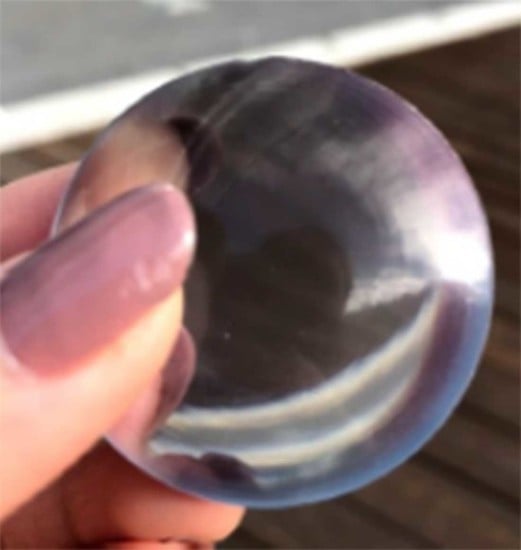Anti-Reflection Coatings on 3D-Printed Components
Abstract
:1. Introduction
2. Materials, Methods and Results
2.1. Standard Clear and VeroClear Materials
2.2. Transmission Spectra
2.3. Refractive Index
2.4. Hardness Maps
2.5. Anti-Reflection Coatings
2.6. Surface Profiles
2.7. Coating Performance
2.8. Fresnel Reflections
3. Discussion and Conclusions
Author Contributions
Funding
Institutional Review Board Statement
Informed Consent Statement
Data Availability Statement
Acknowledgments
Conflicts of Interest
References
- Heinrich, H.; Rank, M. 3D Printing of Optics; Spotlight, SL39; SPIE: Washington, DC, USA, 2018; 42p, ISBN 9781510619982. [Google Scholar]
- Assefa, B.G.; Pekkarinen, M.; Partanen, H.; Biskop, J.; Turunen, J.; Saarinen, J. Imaging-quality 3D-printed centimeter-scale lens. Opt. Express 2019, 27, 12630–12637. [Google Scholar] [CrossRef] [PubMed]
- Canning, J.; Cook, K. 3D printing, photonics and the IoT. In Proceedings of the Conference on Lasers and Electro-Optics/Pacific Rim 2018, Optical Society of American, Hong Kong, China, 29 July–3 August 2018; p. F1B-1. [Google Scholar]
- Lertvachirapaiboon, C.; Baba, A.; Shinbo, K.; Kato, K. Dual-mode surface plasmon resonance sensor chip using a grating 3D-printed prism. Anal. Chim. Acta 2021, 1147, 23–29. [Google Scholar] [CrossRef] [PubMed]
- Wolfe, D.; Goossen, W.W. Evaluation of 3D printed optofluidic smart glass prototypes. Opt. Express 2018, 26, A85–A98. [Google Scholar] [CrossRef] [PubMed]
- Gross, B.C.; Anderson, K.B.; Meisel, J.E.; McNitt, M.I.; Spence, D.M. Polymer Coatings in 3D-Printed Fluidic Device Channels for Improved Cellular Adherence Prior to Electrical Lysis. Anal. Chem. 2015, 87, 6335–6341. [Google Scholar] [CrossRef] [PubMed] [Green Version]
- Ho, W.H.; Tshimanga, J.J.; Ngoeppe, M.N.; Jermy, M.C.; Geodhegan, P.H. Evaluation of a desktop 3D printed rigid refractive-indexed-matched flow phantom for PIV measurements on cerebral aneurysms. Cardiovasc. Eng. Technol. 2019, 11, 14–23. [Google Scholar] [CrossRef] [Green Version]
- Available online: https://www.stratasys.com/explore/blog/2015/3d-printed-led-light-pipesZ (accessed on 10 November 2021).
- Hossain Md, A.; Canning, J.; Yu, Z. Fluorescence-based quality assurance of olive oils using an endoscopy smart mobile spectrofluorometer. IEEE Sens. J. 2020, 20, 4156–4163. [Google Scholar] [CrossRef]
- Canning, J.; Hossain, M.A.; Han, C.; Chartier, L.; Cook, K.; Athanaze, T. Drawing optical fibres from 3D printers. Opt. Lett. 2016, 41, 5551–5554. [Google Scholar] [CrossRef] [PubMed]
- Prajzler, V.; Kulha, P.; Knietel, M.; Enser, H. Large core plastic planar optical splitter fabricated by 3D printing technology. Opt. Commun. 2017, 400, 38–42. [Google Scholar] [CrossRef]
- Cook, K.; Canning, J.; Leon-Saval, S.; Redi, Z.; Hossain, M.; Comatti, J.-E.; Luo, Y.; Peng, G.-D. Air-structured optical fibre drawn from a 3D-printed optical preform. Opt. Lett. 2015, 40, 3966–3999. [Google Scholar] [CrossRef] [PubMed] [Green Version]
- Cook, K.; Balle, G.; Canning, J.; Chartier, L.; Athanze, T.; Hossain, M.A.; Han, C.; Comatti, J.-E.; Luo, Y.; Peng, G.-D. Step-index optical fibre drawn from 3D printed preforms. Opt. Lett. 2016, 41, 4554–4557. [Google Scholar] [CrossRef] [PubMed]
- Chu, Y.; Fu, X.; Luo, Y.; Canning, J.; Tian, Y.; Cook, K.; Zhang, J.; Peng, G.-D. Silica optical fibre drawn from 3D printed preforms. Opt. Lett. 2019, 44, 5358–5361. [Google Scholar] [CrossRef] [PubMed]
- Vaidya, N.; Solgaard, O. 3d printed optics with nanometer scale surface roughness. Microsys. Nanoeng. 2018, 4, 18. [Google Scholar] [CrossRef] [PubMed]
- Available online: https://www.stratasys.com/materials/search/veroclear (accessed on 10 November 2021).
- Bhowmik, K.; Peng, G.D. Polymer Optical Fibers. In Handbook of Optical Fibers; Peng, G.D., Ed.; Springer: Singapore, 2019. [Google Scholar]
- Bennet, J.; Measuring, U.V. Curing parameters of commercial photopolymers used in additive manufacturing. Addit. Manuf. 2017, 18, 203–212. [Google Scholar]
- Miyasaka, M.; Koike, N.; Fujiwara, Y.; Kudo, H.; Nishikubo, T. Synthesis of hyperbranched fluorinated polymers with controllable refractive indices. Polymer J. 2011, 43, 325–329. [Google Scholar] [CrossRef] [Green Version]
- Sun, X.; Xu, X.; Tu, J.; Yan, P.; Song, G.; Zhang, L.; Zhang, W. Research status of antireflection film based on TiO2. Mater. Sci. Eng. 2019, 490, 022074. [Google Scholar] [CrossRef]
- Dumas, L.; Quesnel, E.; Pierre, F.; Bertin, F. Optical properties of magnesium fluoride thin films produced by argon ion-beam assisted deposition. J. Vac. Sci. Technol. 2002, 20, 102. [Google Scholar] [CrossRef]
- Hausner, M. Specifications and Standards for Optical Coating Durability; SPIE Spotlight: Washington, DC, USA, 2019. [Google Scholar] [CrossRef]
- Chicot, D.; Tricoteaux, A. Mechanical properties of ceramics by indentation: Principle and applications. In Ceramic Materials; Wunderlich, W., Ed.; InTech: London, UK, 2010; Chapter 7. [Google Scholar]
- Habeeb, S.A.; Alobad, Z.K.; Albozahid, M.A. Effect of zinc oxide loading levels on the cure characteristics, mechanical and aging properties of the epdm rubber. J. Mechan. Eng. Tech. 2018, 9, 133–141. [Google Scholar]
- Available online: https://www.komachine.com/en/companies/millenium-optical-system/products/43463-Single-Layer-Magnesium-Fluoride-(MgF2)/ (accessed on 10 November 2021).

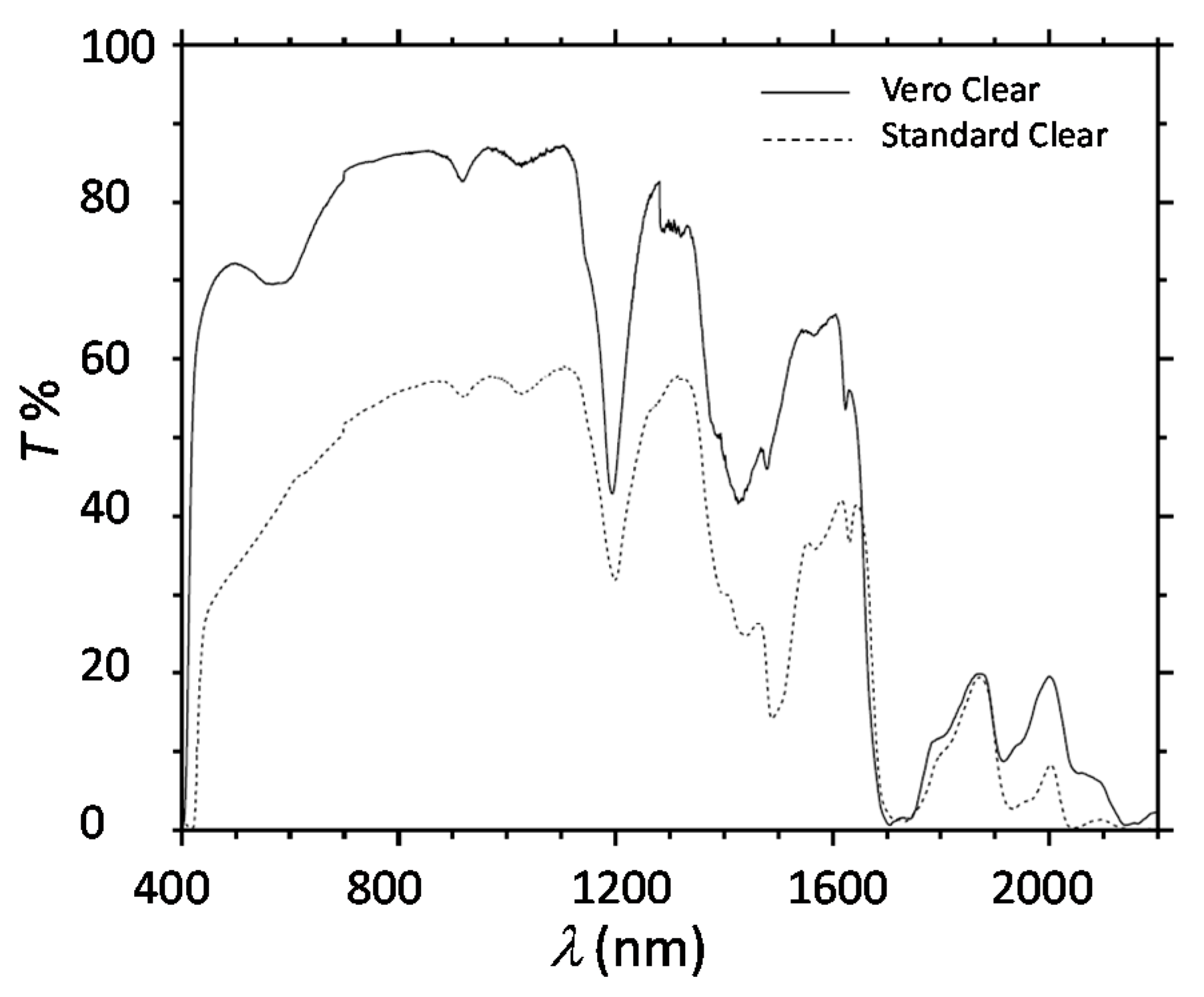

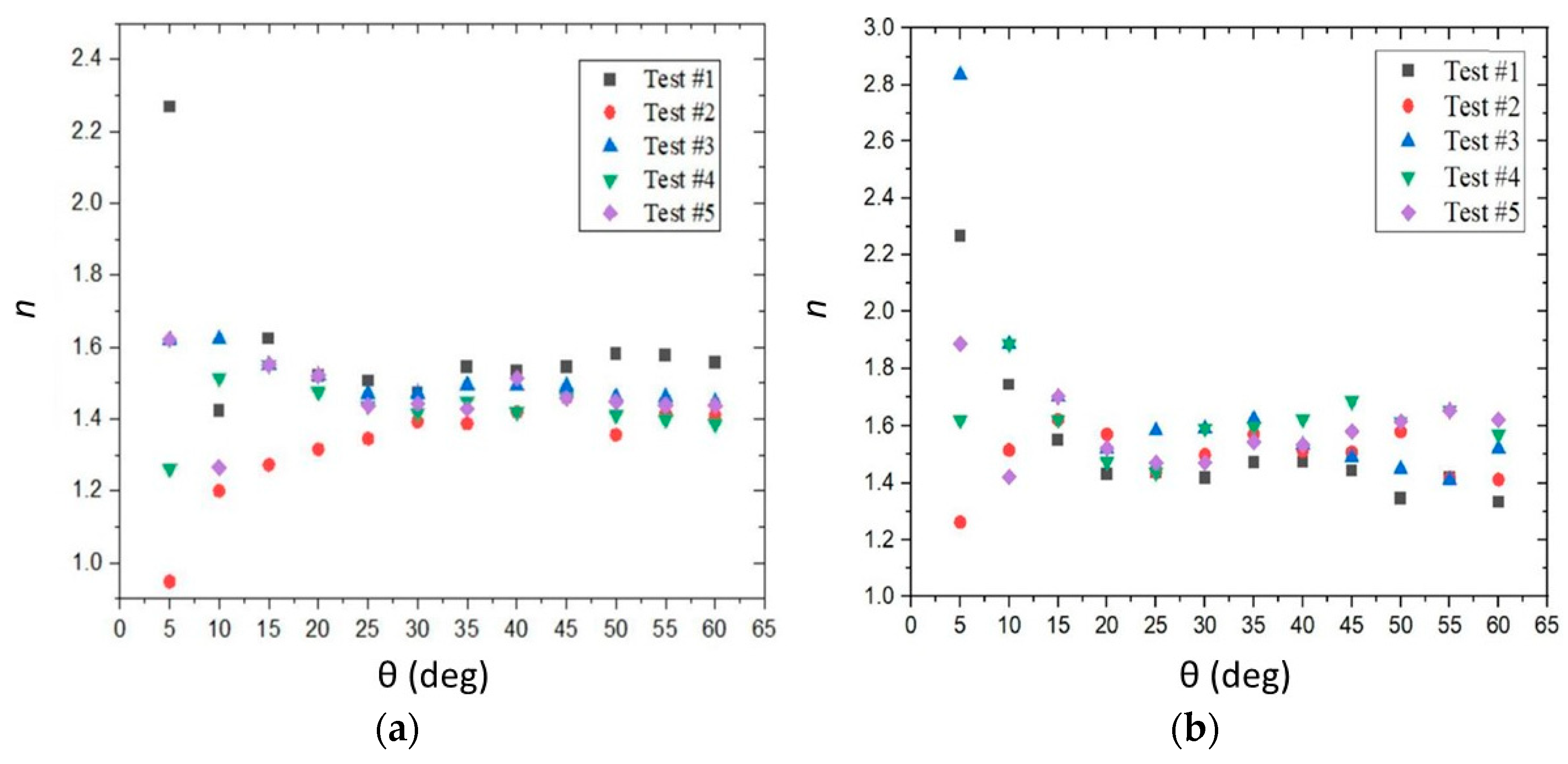


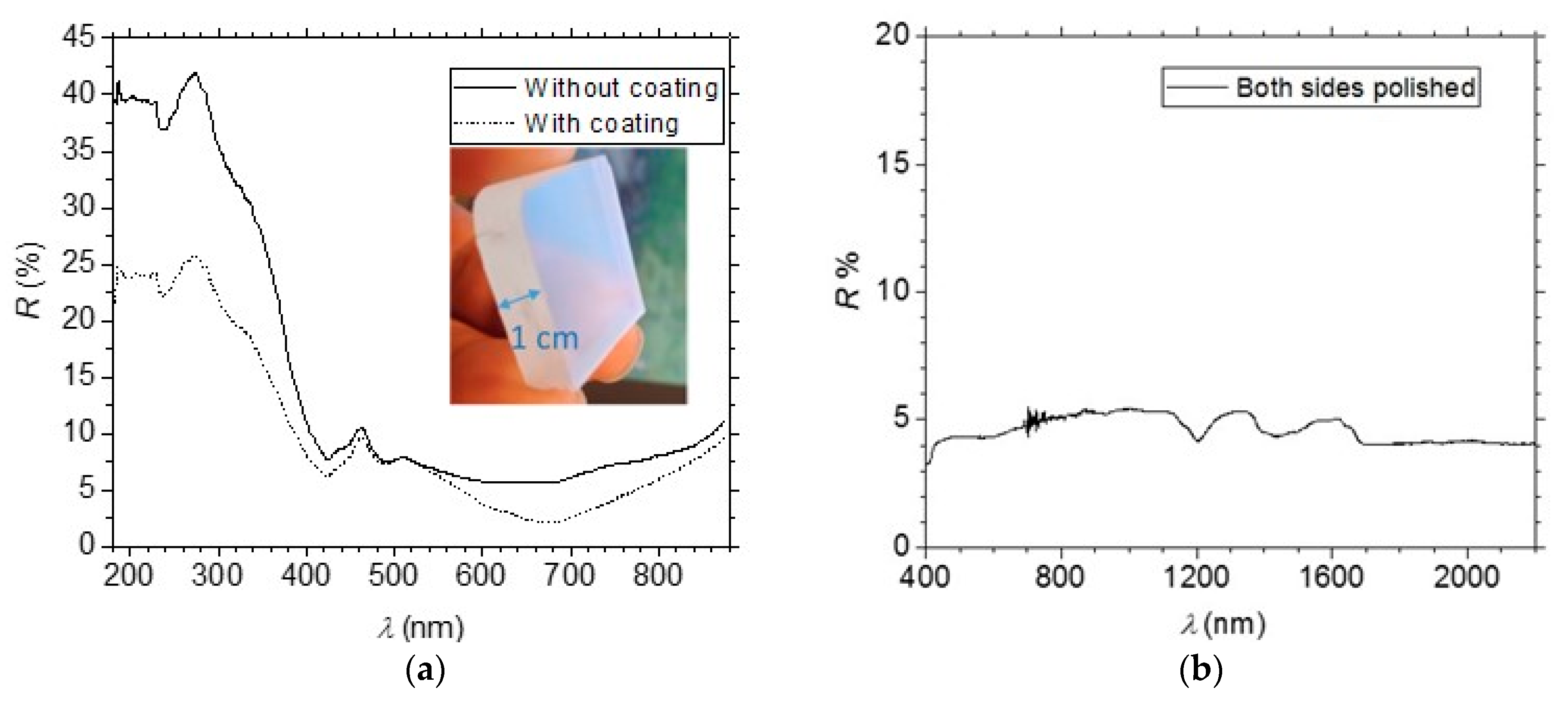
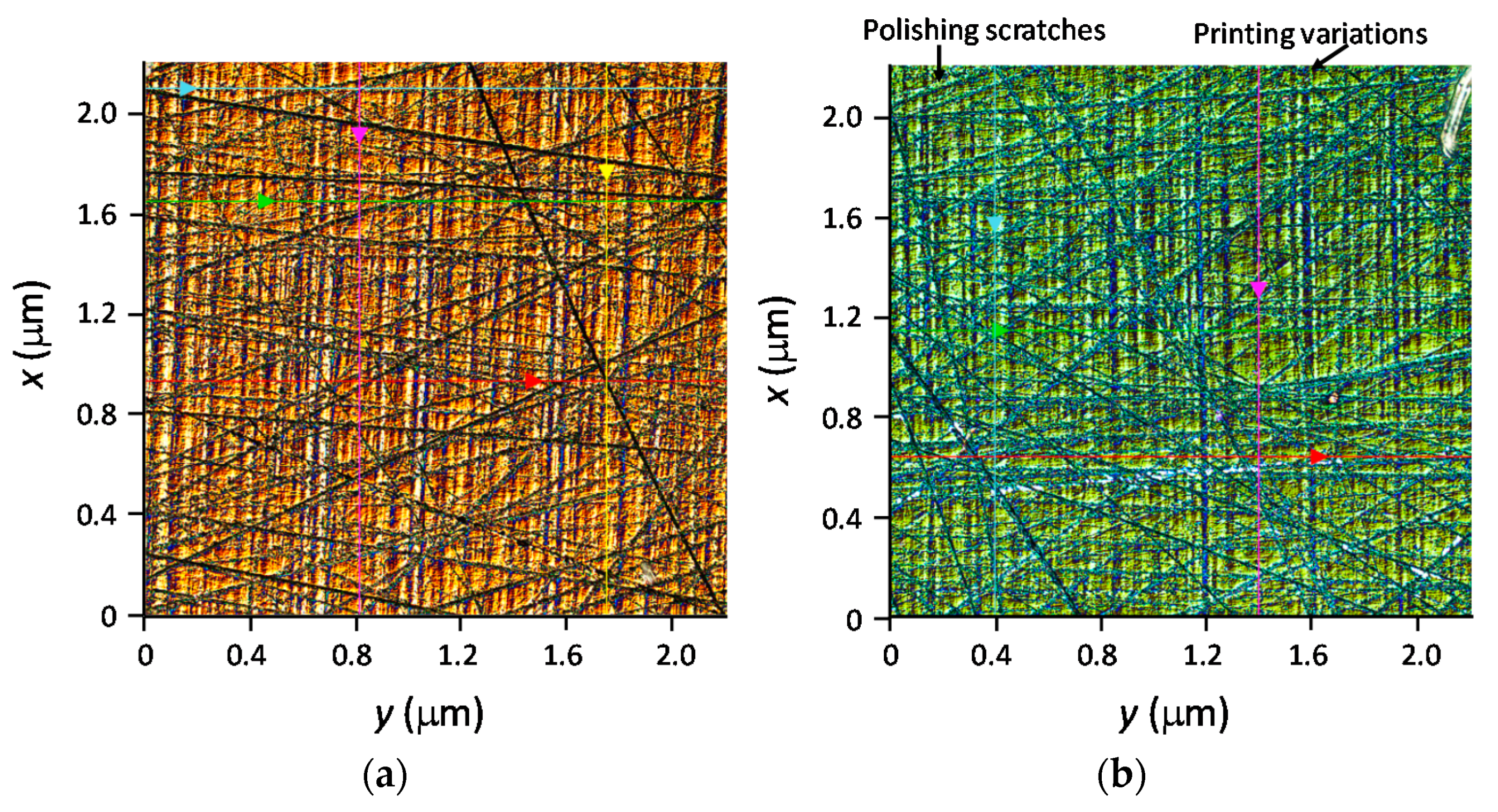
Publisher’s Note: MDPI stays neutral with regard to jurisdictional claims in published maps and institutional affiliations. |
© 2021 by the authors. Licensee MDPI, Basel, Switzerland. This article is an open access article distributed under the terms and conditions of the Creative Commons Attribution (CC BY) license (https://creativecommons.org/licenses/by/4.0/).
Share and Cite
Canning, J.; Clark, C.; Dayao, M.; de LaMela, D.; Logozzo, M.; Zhao, J. Anti-Reflection Coatings on 3D-Printed Components. Coatings 2021, 11, 1519. https://doi.org/10.3390/coatings11121519
Canning J, Clark C, Dayao M, de LaMela D, Logozzo M, Zhao J. Anti-Reflection Coatings on 3D-Printed Components. Coatings. 2021; 11(12):1519. https://doi.org/10.3390/coatings11121519
Chicago/Turabian StyleCanning, John, Caspar Clark, Monica Dayao, Daniel de LaMela, Michael Logozzo, and Jing Zhao. 2021. "Anti-Reflection Coatings on 3D-Printed Components" Coatings 11, no. 12: 1519. https://doi.org/10.3390/coatings11121519





